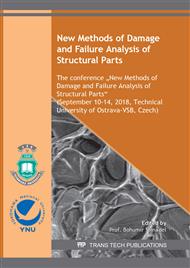[1]
Džugan, J., Konopik, P., Rund, M., Prochazka, R., Determination of local tensile and fatigue properties with the use of sub-sized specimens, (2015) American Society of Mechanical Engineers, Pressure Vessels and Piping Division (Publication) PVP, 1A.
DOI: 10.1115/pvp2015-45958
Google Scholar
[2]
Dzugan, J.; Novy, Z.; Konopik, P.; Improvement Of Fatigue Properties Of 34CrNiMo6 Steel By Controlled Thermomechanical Treatment, METAL 2010: 19th International Metallurgical And Materials Conference, May 18-20, 2010, Roznov Pod Radhostem, Czech Republic. pp.421-426.
Google Scholar
[3]
Jirková, H., Rubešová, K., Konopík, P., Opatová, K., Effect of the Parameters of Semi-Solid Processing on the Elimination of Sharp-Edged Primary Chromium Carbides from Tool Steel, Metals - Open Access Metallurgy Journal 8(9):713, SEP (2018).
DOI: 10.3390/met8090713
Google Scholar
[4]
Dzugan, J., Sindelarova, M., at al.: Specimens Preparation Influence on Results of Micro-Tensile Tests, SEEIE 2016, Pages: 557-561, Location: Bangkok, THAILAND, MAR 20-21, (2016).
DOI: 10.12783/dteees/seeie2016/4686
Google Scholar
[5]
Luong, M.P., 1995. Infrared thermographic scanning of fatigue in metals. Nuclear Eng Des, pp.363-376.
Google Scholar
[6]
Luong, M.P., 1998. Fatigue limit evaluation of metals using an infrared thermographic technique. Mech Mater, p.155–163. P.G. Clem, M. Rodriguez, J.A. Voigt and C.S. Ashley, U.S. Patent 6,231,666, (2001).
DOI: 10.1016/s0167-6636(97)00047-1
Google Scholar
[7]
La Rosa, G., Risitano, A., 2000. Thermographic methodology for rapid determination of the fatigue limit of materials and components. Int J Fatigue 2000; p.65–73.
DOI: 10.1016/s0142-1123(99)00088-2
Google Scholar
[8]
La Rosa, G., Risitano, A., 2000. Thermographic methodology for rapid determination of the fatigue limit of materials and components. Int J Fatigue 2000; p.65–73.
DOI: 10.1016/s0142-1123(99)00088-2
Google Scholar
[9]
De Finis, R., Palumbo, D., Ancona, F., Galietti, U., Fatigue limit evaluation of various martensitic stainless steels with new robust thermographic data analysis, Int J Fatigue 74, 2015, pp.88-96.
DOI: 10.1016/j.ijfatigue.2014.12.010
Google Scholar
[10]
Shiozawa, D., Inagawa, T., Washio, T., Sakagami, T., Fatigue limit estimation of stainless steels with new dissipated energy data analysis, Procedia Structural Integrity Vol 2, 2016, pp.2091-2096.
DOI: 10.1016/j.prostr.2016.06.262
Google Scholar
[11]
Luong, M.P., 1992. Infrared thermography of fatigue in metals. SPIE 1992; pp.222-233.
Google Scholar


